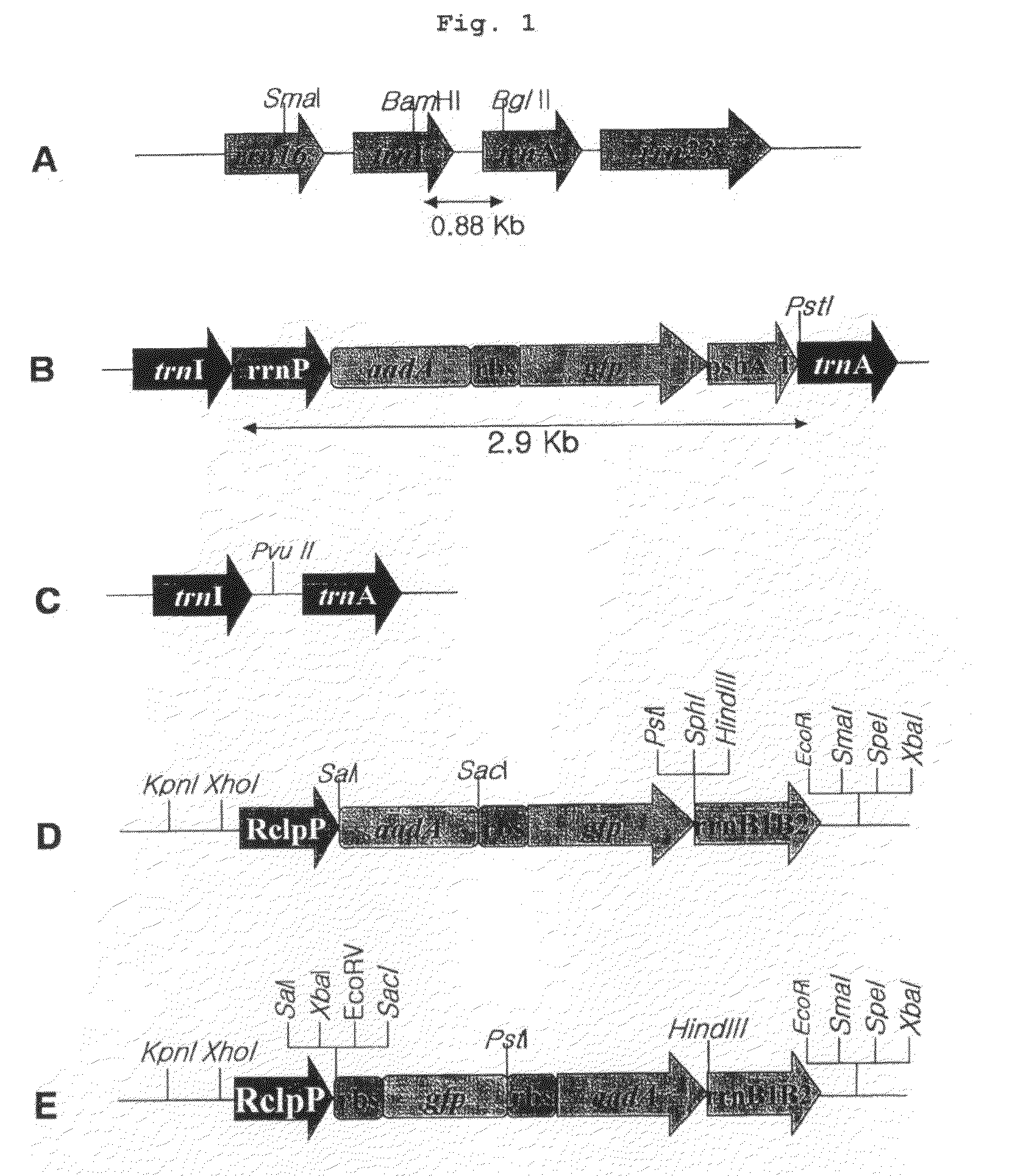The Method for Enhancement of Photosynthesis and Biomass of Plant by Plastid Transformation of Malate Dehydrogenase
a technology of plastid transformation and plastid dehydrogenase, which is applied in the field of enhancement of photosynthesis and biomass of plants by plastid transformation with mdh gene, can solve the problems of inability to ensure stable expression of a foreign gene, low transformation efficiency of plants except tobacco, etc., and achieves enhanced photosynthesis or biomass, increased oxygen generation, and increased leaf area.
- Summary
- Abstract
- Description
- Claims
- Application Information
AI Technical Summary
Benefits of technology
Problems solved by technology
Method used
Image
Examples
example 2
Construction of Vector for Plastid Transformation Containing MDH
[0051]The basic vector shown in FIG. 1 was used as a vector for plastid transformation containing MDH. First, PCR was performed using chromosome DNA of Corynebacterium glutamicum as a template with MDH 5′ primer (SEQ. ID. NO: 11) and MDH 3′ primer (SEQ. ID. NO: 12), followed by cloning into pGEM T-easy vector (Promega, USA). The constructed vector was named “TvecMDH”. PCR was performed with exTaq enzyme (TaKaRa, Japan) as follows; predenaturation at 94° C. for 5 minutes, denaturation at 94° C. for 30 seconds, annealing at 55° C. for 30 seconds, polymerization at 72° C. for 1 minute, 27 cycles from denaturation to polymerization, and final extension at 72° C. for 5 minutes. TvecMDN vector was digested with SalI / HindIII to cut MDH DNA, which was inserted into SalI / HindIII site of pRclPADGHT vector to construct RclpMDH vector. The RclpMDH vector was digested with XhoI / EcoRI and the ends were blunted by treating Klenow enzy...
example 3
Construction of Plastid Transformed Tobacco Plant by Using the Vector for Plastid Transformation Containing MDH
[0052]Plastid transformation was performed by using the vector constructed in Example 2 and the vector CtVG04 constructed in Example 1 was used for the control group.
[0053]After germinating wild type tobacco (Nicotiana tabacum, Samsun) seeds in a chamber for 8 weeks, leaves were separated from the young plant and explanted in MS medium supplemented with 1 mg / l BAP and 0.1 mg / l NAA for further use in plastid transformation.
[0054]Gold particles (0.6 μm in diameter) were coated with the vectors for plastid transformation constructed in Examples 1 and 2 by using CaCl2 and spermidine, followed by transformation using PDH-1000 / He gene delivery system (BioRad, USA) under the conditions of 100 psi acceleration power, 9 cm target distance and 28 in / Hg vacuum.
[0055]The tobacco plant leaves treated above were cultured for 2 days at 25° C. under dark condition with 2,000 lux of light. ...
example 4
Southern Blotting with Plastid Transformed Tobacco Plant
[0057]Southern blotting was performed using trnA gene as a marker to investigate homoplasmy of chloroplast in the T0 and T1 transformants obtained in Example 3. For the Southern blotting, total chromosome DNA was extracted by using a DNA extraction kit (DNeasy Plant Mini Kit, QIAGENE, Germany). 4 μg of the extracted DNA was digested with BamHI and BglII, which proceeded to electrophoresis on 1% agarose gel, followed by blotting on a blotting membrane (Zeta-Probe GT blotting membrane: Bio-Rad, USA). To prepare a probe, 0.6 kb BamHI / BglII DNA fragment containing trnA was labeled with [α-32P]dCTP. Prehybridization and hybridization were performed using 0.25 M sodium phosphate buffer (pH 7.2) containing 7% (w / v) SDS at 65° C. for overnight. Upon completion of the reaction, the membrane was washed with 20 mM sodium phosphate buffer (pH 7.2) containing 5% (w / v) SDS at 65° C. for 30 minutes, which was then exposed for 3 hours.
[0058]As...
PUM
| Property | Measurement | Unit |
|---|---|---|
| Luminosity | aaaaa | aaaaa |
Abstract
Description
Claims
Application Information
 Login to View More
Login to View More - R&D
- Intellectual Property
- Life Sciences
- Materials
- Tech Scout
- Unparalleled Data Quality
- Higher Quality Content
- 60% Fewer Hallucinations
Browse by: Latest US Patents, China's latest patents, Technical Efficacy Thesaurus, Application Domain, Technology Topic, Popular Technical Reports.
© 2025 PatSnap. All rights reserved.Legal|Privacy policy|Modern Slavery Act Transparency Statement|Sitemap|About US| Contact US: help@patsnap.com



